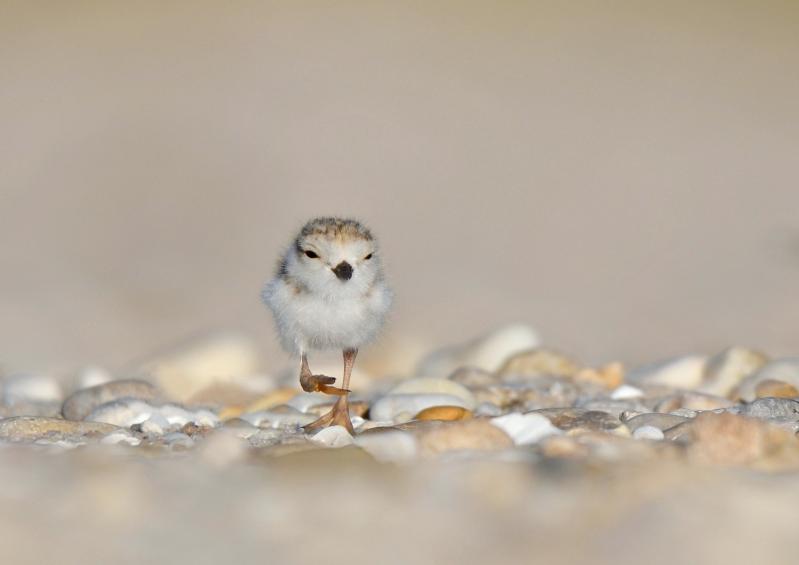Crows, foxes, dogs, trucks, truck tracks, people. Oh, and ghost crabs.
These have been some of the threats to East Hampton Town’s piping plover population in 2025 (ignoring habitat loss) according to Samantha Schurr, an environmental analyst in the Natural Resources Department, who gave an update to the town board on Sept. 2.
“Fox was a terror this year,” she said. “We caught probably five or six nests being eaten by a fox. Along the ocean there were a lot of losses.”
“Chicks are mobile and within hours of their hatch, they can walk, but not well,” Ms. Schurr told the board. “They tend to fall into tire tracks and have a hard time climbing out. Dogs will chase plovers, or maybe just sniff along and step on eggs. We ask that dogs stay out of the plover fencing and walk along the water line.”
Unfortunately, visit any beach during the nesting months and you’re likely to see an off-leash dog trailed by an unwitting owner, often looking into their phone and not monitoring the dog’s whereabouts. East Hampton Town does not have a leash law.
Her department has tried new tactics to deter crows, Ms. Schurr said. “They see our truck and remember our faces. Once we leave, they take the eggs. They also see blue and green very well, and our flagging for nests was blue, so it was like a target. This year we used orange flagging with pink, so it was harder for the crows to see.”
The town monitors over 18 miles of bay and ocean beaches and closes off a very small fraction of it for the plovers. Ms. Schurr noted that birds who have nested successfully often return to the same stretch of beach the following year, giving the staff a hint of where to place the fencing.
The plovers arrive by the end of March and attempt to establish nesting territories. By April pairs have formed, with many incubating eggs by May. Most eggs hatch by the July 4 holiday, but if the first nesting attempt is unsuccessful, the pair will try again.
“It takes about 25 to 35 days before [the chicks] can fly and are counted towards our productivity for the year,” said Ms. Schurr. “The fencing is taken down beginning in middle July to the end of August, based on whether the sites are inactive or if they have already fledged. If a pair is successful on their first nesting attempt, the beach access will open much sooner.”
The U.S. Fish and Wildlife Service has been trying to stabilize the Atlantic piping plover population, which is listed as federally threatened, for nearly 40 years. In our region, which also includes New Jersey, plovers must achieve a fiveyear average productivity of 1.5 fledged chicks per pair to be considered for list removal, and must maintain an average population of 575 pairs. (The local plover population had poor productivity numbers this summer, with a rate of just 1.05.)
Separate from their federal status, piping plovers are listed as “endangered” by New York State.
Since 2008, there has been a downtrend here for successful fledges. The last three years have had some of the lowest numbers since the town began keeping records, according to a graph accompanying last year’s report, when the productivity rate was 1.28. According to the New York State Department of Environmental Conservation, Island-wide, in 2024, it was 1.4.
While East Hampton’s productivity seems to be underperforming the rest of the Island, the D.E.C. says there’s no way to compare one township to the next. “Due to different habitat types in various areas and different challenges, townships are not ranked by success and cannot be fairly compared in many instances,” wrote a spokesperson in an email.
“While the town may have a large amount of beach area, all beaches are not created equal as far as plovers are concerned. For example, Jones Beach is very wide and has exceptional foraging in that it has ephemeral pools. This is an area where there is a high density of plovers because the habitat can support it. A narrow ocean beach without ephemeral pools or bayside feeding access may not be as productive.”
Indeed, Montauk is an example of that point. While “The End” is known for its beaches, it made news this season when a fireworks show had to be canceled because of the presence of a piping plover nest, the first ever recorded in the hamlet.
Ms. Schurr said the nest might be related to the Fire Island to Montauk Point beach replenishment project. “Now that there’s more beach, it’s a much more attractive nesting spot. Next year we’re going to get out there early.”
The D.E.C. did offer a sliver of good news. There were more piping plover pairs, 526, attempting to mate on Long Island in 2024 than ever before. That’s over 1,000 individual birds. To put that number into perspective, the worldwide plover population is between 6,000 and 8,000 birds, highlighting the Island’s importance to their survival.

